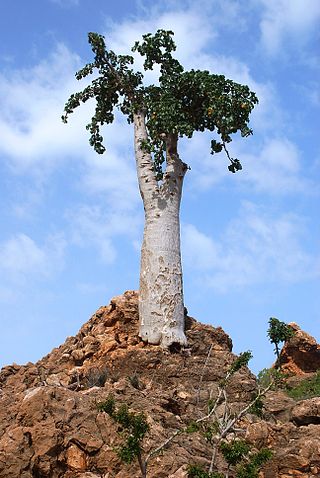Cephalocrotonopsis is a genus of plant of the family Euphorbiaceae first described as a genus in 1910. It contains only one known species, Cephalocrotonopsis socotranus, endemic to the Socotra Islands in the Indian Ocean, part of the Republic of Yemen.
Hibiscus socotranus is a species of flowering plant in the family Malvaceae. It is found only in Yemen. Its natural habitat is subtropical or tropical dry shrubland.
Melhania milleri is listed in the 2004 IUCN Red List as a species of flowering plant in the family Malvaceae, endemic to Socotra, with its natural habitats being subtropical or tropical dry forests and subtropical or tropical dry shrubland. As of March 2023, the species was not listed by the International Plant Names Index, nor by other taxonomic databases such as Plants of the World Online.
Andropogon bentii is a species of grass in the family Poaceae. It is found only in the Socotra archipelago in the Indian Ocean, a part of Yemen. Its natural habitat is succulent and dwarf shrubland on limestone escarpments and plateaus.
Hypericum balfourii is a species of flowering plant in the family Hypericaceae. It is endemic to Socotra, an island archipelago that is part of Yemen. It grows in mountain shrubland dominated by Cephalocroton. It is usually found on granite terrain above 600 meters in elevation.

Hypericum scopulorum is a species of flowering plant in the family Hypericaceae. It is endemic to Socotra, an island archipelago that is part of Yemen. It is a common plant in shrubland habitat, and it is a dominant species in some areas along with Cephalocroton and another local endemic, Libinhania rosulata.
Coleus socotranus, synonym Plectranthus socotranus, is a species of flowering plant in the family Lamiaceae.
Acridocarpus socotranus is a species of plant in the family Malpighiaceae. It is endemic to Socotra, an archipelago which is part of Yemen. It occurs in woodlands, thickets, and succulent shrubland habitat, where it is a common species.

Euphorbia arbuscula is a species of plant in the spurge family (Euphorbiaceae). It is endemic to the archipelago of Socotra in Yemen. Its natural habitats are subtropical or tropical dry forests and subtropical or tropical dry shrubland.

Kalanchoe robusta is a species of plant in the family Crassulaceae. It is endemic to the Yemeni island of Socotra. Its natural habitat is on rocky slopes and amongst limestone boulders in dwarf shrubland and low succulent shrubland at an altitude of 300–750m. While it is listed by IUCN as belonging to the order Rosales, Kalanchoes and other Crassulaceae are more usually placed in Saxifragales.
Lannea transulta is a species of plant in the family Anacardiaceae. It is endemic to Yemen. Its natural habitats are subtropical or tropical dry forests and subtropical or tropical dry shrubland.

Cynanchum socotranum, synonym Sarcostemma socotranum, is a species of plant in the family Apocynaceae. It is endemic to Socotra Island, south of Yemen. Its natural habitat is subtropical or tropical dry shrubland.
Convolvulus socotranus is a species of plant in the family Convolvulaceae. It is endemic to Socotra. Its natural habitat is subtropical or tropical dry shrubland.

The Socotra Island xeric shrublands is a terrestrial ecoregion that covers the large island of Socotra and several smaller islands that constitute the Socotra Archipelago. The archipelago is in the western Indian Ocean, east of the Horn of Africa and south of the Arabian Peninsula. Politically the archipelago is part of Yemen, and lies south of the Yemeni mainland.

The Socotra golden-winged grosbeak or Socotra grosbeak is a finch endemic to Socotra, an island in the Indian Ocean off the coast of Yemen. R. socotranus is by some authorities held to be the only species of the then-monotypic genus Rhynchostruthus, including all other golden-winged grosbeaks therein as subspecies. But in recent times the three populations are usually considered a distinct species, with R. socotranus being limited to the Socotra population, the Arabian golden-winged grosbeak becoming R. percivali, and the Somali golden-winged grosbeak R. louisae.

Dendrosicyos is a monotypic genus in the plant family Cucurbitaceae. The only species is Dendrosicyos socotranus, the cucumber tree. The species is endemic to the island of Socotra in Yemen, and is the only species in the Cucurbitaceae to grow in a tree form. The species name was originally spelled D. socotrana, but this is corrected to masculine grammatical gender according to the International Code of Nomenclature for algae, fungi, and plants.

Cissus subaphylla is a low shrub in the grape family Vitaceae. It is endemic to the Yemeni island of Socotra. The plant grows mainly in dry, low-lying areas on alluvial fans or on limestone slopes, and is rarely found above elevations of 300 metres (980 ft), where it is replaced by C. hamaderohensis. It does not have the climbing habit of other Cissus species, and its stems are flattened and gray-green in colour, with relatively small leaves and flowers. The tangled mats of C. subaphylla stems act as a protective covering for plants regularly eaten by goats and other browsing animals; the plant is thus important in the rehabilitation of species such as Dendrosicyos, Maerua and Commiphora.
The wildlife of Yemen is substantial and varied. Yemen is a large country in the southern half of the Arabian Peninsula with several geographic regions, each with a diversity of plants and animals adapted to their own particular habitats. As well as high mountains and deserts, there is a coastal plain and long coastline. The country has links with Europe and Asia, and the continent of Africa is close at hand. The flora and fauna have influences from all these regions and the country also serves as a staging post for migratory birds.

Commiphora socotrana is a species of flowering plant in the incense tree family Burseraceae, native to Socotra. A shrub or small tree, it is dominant in the laakam myrrh tree shrubland and is found in many other woodland and shrubland biotopes.










